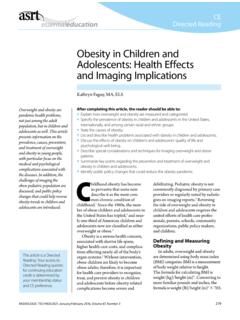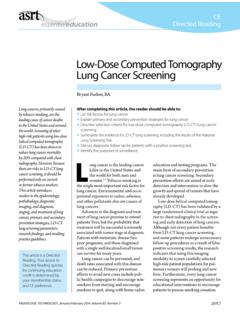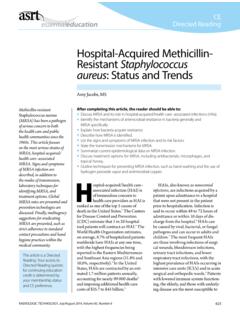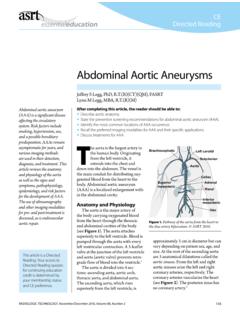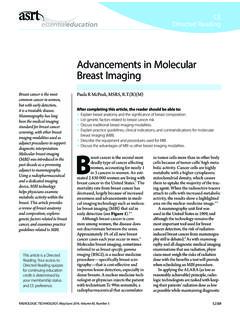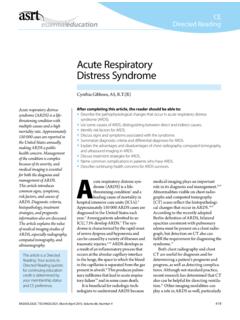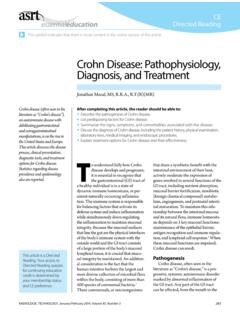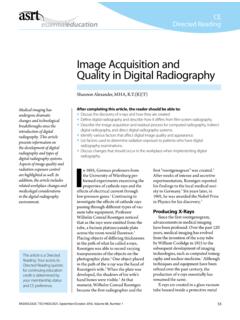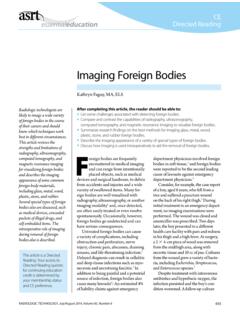Transcription of Managing Multiple Generations in the Workplace
1 379 RADIOLOGIC TECHNOLOGY, March/April 2017, Volume 88, Number 4 CEDirected ReadingThis article is a Directed Reading. To earn continuing education credit for this article, see the instructions on Page s Workplace often includes workers from 4 distinct Generations , and each generation brings a unique set of core values and characteristics to an organization. These generational differences can produce benefits, such as improved patient care, as well as challenges, such as conflict among employees. This article reviews current research on generational differences in educational settings and the Workplace and discusses the implications of these findings for medical imaging and radiation therapy completing this article, the reader should be able to: Identify the various generational cohorts in today s Workplace . Discuss distinguishing characteristics of each generation and describe their respective Workplace behaviors.
2 Describe the challenges and opportunities associated with a diverse Workplace . Explain common stereotypes associated with each generation. Discuss the effects of generational differences on medical imaging and radiation therapy R Clark, EdD, (R) Managing Multiple Generations in the WorkplaceToday s multigenerational work-force presents opportunities and challenges for medical imaging and radiation therapy departments. Because some employees are working into their late 60s and 70s, it is common to see several generational cohorts working together, creating a unique work A lthough multigenerational diversity among health care staff can result in sound decisions and improved patient care, varied attitudes, values, beliefs, work ethics, and expectations can present challenges, too. As Multiple Generations continue working side by side, manag-ers and organizations can promote a unified work environment by embrac-ing generational differences and encouraging mutual understanding and ,3 Generations DefinedA generation is defined as a group of individuals born and living con-temporaneously who share common knowledge and experiences that affect their thoughts, attitudes, values, beliefs, and A lthough no consensus exists regarding when 1 generation ends and another begins, experts agree that individuals who grew up in the same era experienced social and historical events that shaped similar characteris-tics and core Ta ble 1 displays some of the historical and social events that inf luenced each generational cohort: veterans, baby boomers, genera-tion X, and generation Y.
3 It is important to note that individuals from a specific generation might not exhibit all or even any of the characteristics ascribed to the group as a In fact, individu-als might start to display characteristics of the next older generation as they advance in their , also referred to as tradi-tionalists and the silent generation, were born before 1946 and are the oldest gen-eration in American About 380 RADIOLOGIC TECHNOLOGY, March/April 2017, Volume 88, Number 4 CEDirected ReadingManaging Multiple Generations in the Workplaceveterans are continuing to work later in ,2,5 In addi-tion, health care organizations have a vested interest in understanding this generation because most Medicare beneficiaries a signficiant portion of the health care consumer and patient populations are ,12 Baby BoomersBaby boomers were born between 1946 and 1964 and are one of the largest generational cohorts in the United States, comprising about 76 million Those born between 1946 and 1955 are referred to as early boomers, and those born after 1955 are referred to as late Members of this generation grew up in a relatively steady state of free expression, economic prosperity, and an absence of world wars, although they lived through the Cold War era and the Vietnam ,9 As young adults, baby boomers experienced opportunities that were not available to their predecessors.
4 Typically, they were the first in their families to earn college degrees, and their education translated into upward In school, baby boomers needed to collaborate and cooperate with their peers because there were so many of them. As a result, this generation possesses both teamwork and relationship-building well established in their careers and in positions of power and authority, baby boomers are extremely hard workers and are committed to their professional In fact, this driven and dedicated generation s motto is living to work, 9 and they are credited with creating the term In addi-tion, baby boomers are described as optimistic, friendly, 55 million veterans reside in the United States People from this generation grew up during the Great Depression, and many fought or were children during World War ,9 The hardships of the war and the econo-my deeply affected this generation s values and opinions regarding family, religion, work, and government.
5 For example, veterans are characterized as being patriotic and civic-minded because they witnessed business and government working together during the New Deal to conquer the Great ,8 They also learned to be resourceful to stretch limited funds and make small amounts of food and clothing last. Having overcome economic hardships, they developed a sense of pride and determination and, as a result, tend to work hard and prefer consistency and Described as loyal and disciplined, veterans also value integrity, character, and sacrifice; respect authority and value boundaries between work and family life; and strive for financial lthough some veterans train slowly, they make work a priority and are considered team ,10 They are loyal to their employers; expect the same in return; and believe promotions, raises, and recognition should be based on job tenure and ,8 They also mea-sure work ethic on punctuality and ,9 As expected, veterans often are unsure of and even resist using new ,10 Most veterans have retired, and they constitute only 2% ( million) of the workforce As a result, only limited research regarding their presence in the workforce is available.
6 However, more and more Ta b l e 1 Influential Historical and Social Events2-7 VeteransBaby BoomersGeneration XGeneration YGreat DepressionWorld War IIPearl HarborD-DayKorean WarGolden Age of RadioRise of labor unionsCivil Rights MovementPolitical assassinationsVietnam WarCold WarNeil Armstrong s moon landingWoodstockTelevision becomes dominant mediaWomen s Liberation MovementFirst personal computersAIDSC hallenger disasterFall of Berlin WallRodney King beatingOperation Desert StormOklahoma City Simpson trialDeath of Princess DianaSchool violence (Columbine massacre)Digital Age (Internet, instant messaging, wireless technology)September 11 events 381 RADIOLOGIC TECHNOLOGY, March/April 2017, Volume 88, Number 4 CEDirected ReadingClarkwhile working on independent In fact, they do not align themselves with the philosophy of being a team member, but they will work with colleagues to achieve a common They prefer to manage their own time, set their own limits, and complete their work without This generation also finds infor-mal policies regarding dress codes and Workplace habits to be fun and They expect and embrace change and are technologically sav v X members represent approximately 34% ( million) of the workforce Most thrive in a casual, friendly work environment.
7 However, they desire to build portable careers by exploring employ-ment opportunities and changing jobs periodically to increase their ,8 Generation YMembers of generation Y, commonly referred to as gen Yers, millennials, and nexters, were born between 1981 and ,8 This generation comprises about 80 million people and constitutes the largest gen-erational cohort in the United States Having grown up using computers, mobile phones, tablets, and other electronic devices, generation Y individuals are extremely technologically sav v y and highly con-nected to the ,7,8,13 Unlike the latchkey children of generation X, gen-eration Y grew up being escorted and supervised by protective parents who were extremely cautious of dan-gers such as kidnapping, school violence, and The close interaction between parents and child gave rise to the term helicopter parents, meaning parents who are involved in every aspect of their children s ,8 In general, generation Y members are less independent, more community-oriented, and seek a sense of meaning in greater This generation also is motivated by money and described as being ambitious, having a short attention span, and wanting instant with their predecessors, members of generation Y tend to be more social and confident as they seek a balance between their personal life and A lthough easily bored and impatient, they are motivated by their need for a sense of purpose and belonging to meaningful communities, and they typically enjoy experimenting and discovering new and proud of their strong work They also work longer work weeks than prior Generations did.
8 And they believe continual learning and growth lead to ,9 Motivated by perks, prestige, and position, baby boom-ers want to be recognized for their contributions, and they view work as an exciting ,9,12 Baby boomers represent approximately 29% ( million) of today s The old-est members of this generation are considering their retirement options and are seeking ways and opportunities to make their elder years personally XMembers of generation X, also referred to as gen Xers, busters, and the lost generation, were born between 1965 a nd ,7,8 Approximately 53 million members of the generation X cohort live in the United ,11,13 The term buster describes this generation because their birth rates were vastly lower than those of the baby The lost generation also describes this cohort because it was the first generation of latchkey children those left at home with negligible parental supervision and children exposed to daycare and Many parents of generation X were baby boomers with workaholic tendencies driven by personal gratification, authority, and status.
9 In some cases, their work habits resulted in poor home lives, broken families, and absent A lack of meaningful family relationships led generation X members to create nontraditional families by bonding with friends and their upbringing, it is no surprise that generation X members expect to maintain a balance between work and family life and do not work exceptionally long hours for money or ,9 Generally, they are less loyal to their employers and are more comfortable demanding f lex-ible work They also expect freedom and balance in their personal and professional lives, acknowl-edging that work contributes only a portion of the quality of life they seek to At times, generation X can be cynical, questioning authority and disliking direct ,7,8 Often, they resist micromanaging bosses and find them to be distasteful and independent, self-reliant, and informal, generation X individuals multitask easily and excel 382 RADIOLOGIC TECHNOLOGY, March/April 2017, Volume 88, Number 4 CEDirected ReadingManaging Multiple Generations in the Workplacereal-world application scenarios over creative or ref lective writing In addition, the students appreciated personable professors who tailored their lessons to the group of individuals in a specific and Dunneback acknowledged that their findings were consistent with the general characteristics of millennials, including short attention spans and the need for instant They also recognized the need for future studies involving larger samples to further investigate millennial students perspectives on teaching and learning in a variety of courses.
10 A lthough this study assessed students preferences in the class-room setting only, it is possible that millennial students bring those preferences into the Digital DivideSalajan et al examined the perceptions of dental students and instructors regarding the use of digital learning technologies in the online Most of the instructors were either veterans or baby boom-ers, and most of the students were from generation The researchers wanted to explore the assumption that younger Generations are more technologically sav v y and skilled than older Generations . Specifically, the participants rated their use of email, web brows-ers, e-texts, personal computers, laptops, and MP3 players, as well as the course management system at the beginning of the semester and then at the end of the semester after using the digital technologies in the online results indicated a slight but not statistically significant intergenerational difference in faculty members perceived use of digital technologies, although the researchers did not investigate whether the difference was associated with generational differ-ences between the veteran and baby boomer However, students perceptio
